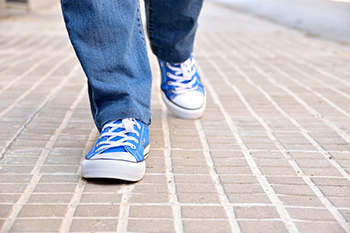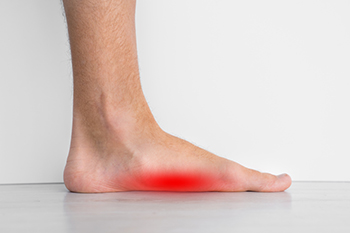Items filtered by date: April 2022
The Way You Walk May Cause Foot Pain
When you walk or run, your gait should have normal pronation, which encompasses a natural side-to-side foot movement with minimal inward rolling. Overpronation is a less desirable step pattern where the ankle rolls excessively inward and downward, causing the arch to flatten the ligaments, muscles, and tendons under the feet to stretch. Only the big toe and second toe push off because the ankle is still rolling. This is not like normal pronation where all of the toes help to push off. Overpronation may cause pain in the heels and arches, which may spread to other areas of the feet, legs, and back. In underpronation, or supination, the rolling occurs on the outside of the foot, which places undue stress on that part of the foot (and the smaller toes) in the push-off stage. Underpronation may cause pain in the ball of the foot and arch, and may also lead to back and knee pain if not corrected. A chiropodist can offer professional advice on choosing shoes, and prescribe custom orthotics that can help correct these gait abnormalities.
Foot pain is a common problem treated by chiropodists. If you have foot pain, please consult with one of the chiropodists from Complete Family Footcare & Therapy. Our clinicians can help you maintain the health of your lower limbs and your mobility.
When you are experiencing foot pain, it’s important to note the type of pain and its location, as this can help determine a diagnosis.
Pain in the top of the foot may be caused by:
-
Stress fractures
-
Sinus tarsi syndrome
-
Extensor tendonitis
-
Tibialis anterior tendonitis
-
Gout
-
Athlete’s foot
-
Ganglion cysts
Pain in the bottom of the foot may be caused by:
-
Plantar fasciitis
-
Foot cramps
-
Tarsal tunnel syndrome
-
Plantar fibromatosis
-
Posterior tibial tendonitis
-
Stress fractures
-
Flat feet
Pain on the side of the foot may be caused by:
-
Ankle sprain
-
Cuboid syndrome
-
Peroneal tendonitis
-
Stress fractures
-
Bunions
-
Corns or calluses
-
Posterior tibial tendonitis
Heel pain may be caused by:
-
Plantar fasciitis
-
Achilles tendonitis
-
Bone spurs
-
Heel fractures
-
Retrocalcaneal bursitis
-
Sever’s disease
Pain in the toes may be caused by:
-
Gout
-
Hammertoe
-
Turf toe
-
Bunions
-
Ingrown toenails
-
Blisters
-
Arthritis
These and many more conditions can be treated by a chiropodist. If you have any questions, please feel free to contact our offices located in . We offer the newest diagnostic and treatment technologies for all your foot care needs.
Recovery Methods for a Broken Ankle
 Several weeks or months is generally needed to fully recover from a broken ankle. After an X-ray is taken that can confirm the fracture, recovery can begin. It is important to refrain from weight bearing activities, and to possibly replace that time with adequate resting. Many patients will purchase a shower chair, and this is an effective method of staying safe while taking a shower. The broken foot may feel better when it is elevated, and this may help to control any swelling. Additionally, when the ankle has completely healed, it is suggested that daily activities are increased gradually, and this can give the ankle time to regain strength. If you have a broken ankle, please confer with a chiropodist who can accurately diagnose this type of fracture, and offer correct treatment options.
Several weeks or months is generally needed to fully recover from a broken ankle. After an X-ray is taken that can confirm the fracture, recovery can begin. It is important to refrain from weight bearing activities, and to possibly replace that time with adequate resting. Many patients will purchase a shower chair, and this is an effective method of staying safe while taking a shower. The broken foot may feel better when it is elevated, and this may help to control any swelling. Additionally, when the ankle has completely healed, it is suggested that daily activities are increased gradually, and this can give the ankle time to regain strength. If you have a broken ankle, please confer with a chiropodist who can accurately diagnose this type of fracture, and offer correct treatment options.
Ankle fractures are serious injuries that require medical attention. If you have broken your ankle, please consult with one of the chiropodists from Complete Family Footcare & Therapy. Our clinicians can help you maintain the health of your lower limbs and your mobility.
Symptoms
-
Pain at the site of the fracture
-
Swelling
-
Bruising
-
Blisters
-
Inability to walk
-
Ankle deformity
-
In the case of an open fracture, bone protruding through the skin
Diagnosis
-
Physical examination
-
Medical history
-
X-ray, bone scan, or other imaging study
Treatments
-
Rest
-
Ice
-
Compression
-
Elevation
-
Immobilization
-
Pain medications
-
Surgery
If you have any questions, please feel free to contact our offices located in . We offer the newest diagnostic and treatment technologies for all your foot care needs.
Toe Walking in Children
 Most little children walk on their toes as they are learning to walk, up until about the age of 2. This is very common and not usually a concern since they eventually stop on their own and begin to walk in a normal heel-to-toe pattern. However, if a child persists in walking on tiptoe, it can cause tightness in the ankle and calf muscles, which may need to be treated. In such cases, treatment can include stretching exercises, a custom brace worn during the day to stretch and encourage a flattened foot position while walking, short-term casting to improve the position of the foot and ankle, and botox injections. In a few more serious cases, surgical treatment can help to stretch the calf muscles, but this is rare. If you are concerned about your child’s pattern of walking on their toes, it is suggested that you set an appointment with a chiropodist for analysis. Testing for gait, range of motion, and muscle tone may be conducted, and suggested treatment options may be discussed.
Most little children walk on their toes as they are learning to walk, up until about the age of 2. This is very common and not usually a concern since they eventually stop on their own and begin to walk in a normal heel-to-toe pattern. However, if a child persists in walking on tiptoe, it can cause tightness in the ankle and calf muscles, which may need to be treated. In such cases, treatment can include stretching exercises, a custom brace worn during the day to stretch and encourage a flattened foot position while walking, short-term casting to improve the position of the foot and ankle, and botox injections. In a few more serious cases, surgical treatment can help to stretch the calf muscles, but this is rare. If you are concerned about your child’s pattern of walking on their toes, it is suggested that you set an appointment with a chiropodist for analysis. Testing for gait, range of motion, and muscle tone may be conducted, and suggested treatment options may be discussed.
If your child is experiencing foot or ankle pain, please consult with one of the chiropodists from Complete Family Footcare & Therapy. Our clinicians will assess your condition and provide you with quality foot and ankle treatment.
Common Causes of Foot Pain in Children
While children can experience many of the same foot problems as adults do, some foot problems may be more common during childhood.
Causes of foot pain in children can include:
-
Deformities that are present from birth, such as flat feet or clubfoot
-
Sever’s disease, which is an inflammation of the growth plate in the heel bone
-
Various sports injuries, such as sprains and fractures
-
Ingrown toenails
-
Athlete’s foot
-
Plantar warts
Prevention
It is important to look after the health of children’s feet in order to prevent future problems from arising. Keep your child’s feet clean and dry, trim their toenails regularly, ensure their shoes fit properly, and keep a watchful eye on any symptoms of foot pain, such as limping. If you notice any symptoms or if your child complains of foot pain, a chiropodist can help.
If you have any questions, please feel free to contact our offices located in . We offer the newest diagnostic and treatment technologies for all your foot care needs.
Read more about Children’s Foot HealthGout Pain Can Be Managed
Are Your Flat Feet Bothering You?
Arches help support your body weight as well as the tendons and ligaments in your feet and lower legs. Babies are born with flat feet and usually develop arches by the time they are 2 or 3 years old. Arches that are considered normal have fully developed and are visible as an upward curve on the sole of your foot. If a person does not develop a normal arch, this is known as having flat feet. Many people with flat feet are asymptomatic, while others experience fatigue, or aching in their feet after significant periods of standing or physical activity. They may also have pain in their hips, knees, or lower back. Flat feet can sometimes lead to alignment issues in certain joints and bones or even bunions. Flat feet in adults may be caused by ligament injuries, rheumatoid arthritis, torn or weakened tendons, or even broken bones. A chiropodist can help treat symptomatic flat feet with physical therapy and stretching exercises, supportive shoes, arch supports, and more.
Flat feet are a common foot condition. If you are experiencing pain or discomfort due to flat feet, please consult with one of the chiropodists from Complete Family Footcare & Therapy. Our clinicians will assess your condition and provide you with quality foot and ankle treatment.
What Are Flat Feet?
Flat feet are feet that do not have a well-defined arch in the middle of the sole of the foot. Flat feet may be flexible or rigid. Flexible flat feet have an arch when there is no pressure put on the foot, such as when one is sitting, but the arch disappears upon standing. Rigid flat feet lack an arch regardless of whether one is standing or not.
Causes
Flat feet can be present from birth or acquired over time due to a weakening of the ligaments in the arch. Sometimes flat feet are caused by illnesses, injuries, or pregnancy.
Symptoms
Flat feet often cause no noticeable symptoms. However, some people may experience pain and discomfort due to their flat feet.
Symptoms associated with flat feet include:
-
Pain in the arch, heel, ankle, or along the outside of the foot
-
Overpronation of the foot
-
Shin splints
-
Aching or fatigue in the feet or legs
-
Pain in the knees, hips, or lower back
Treatment
In cases where flat feet cause symptoms, there are various treatments available. Wearing orthotic inserts in your shoes to provide more arch support, performing stretches, and taking medications may improve your symptoms. If you are overweight, losing weight can help relieve pressure on the feet. In severe cases, surgery may be considered.
If you have any questions, please feel free to contact our offices located in . We offer the newest diagnostic and treatment technologies for all your foot care needs.
Read more about Flat Feet


